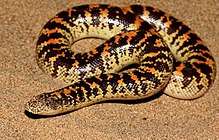Eryx jayakari
Eryx jayakari, known commonly as the Arabian sand boa or Jayakar's sand boa, is a species of snake in the family Boidae.[3] The species is endemic to the Arabian Peninsula and Iran where it spends the day buried in the sand.
| Eryx jayakari | |
|---|---|
 | |
| Scientific classification | |
| Kingdom: | Animalia |
| Phylum: | Chordata |
| Class: | Reptilia |
| Order: | Squamata |
| Suborder: | Serpentes |
| Family: | Boidae |
| Genus: | Eryx |
| Species: | E. jayakari |
| Binomial name | |
| Eryx jayakari | |
Etymology
Both the specific name, jayakari, and one of the common names, Jayakar's sand boa, are in honor of Atmaran S. G. Jayakar (1844–1911), an Indian surgeon and naturalist.[4]
Description
The Arabian sand boa is a small snake growing to a total length (including tail) of about 38 cm (15 in). The eyes are very small and are located on the top of the head, which has a blunt snout and is wedge-shaped. This snake's colour is yellowish-grey or sandy-brown speckled with white flecks and transversely banded with dark marks.[5]
Geographic range
The Arabian sand boa is native to the Arabian peninsula. Its geographic range includes Saudi Arabia, Oman, Yemen, Kuwait, and southern Iran, where a small number of specimens have been found in Khuzestan Province, Bushehr Province and Kerman Province.[1]
Habitat
Eryx jayakari is a desert species of snake, living semi-underground in sand or soft soil.[1]
Behaviour
The Arabian sand boa is largely nocturnal and is tolerant of a wide range of temperatures. During the day it buries itself deep in the sand but moves towards the surface at dusk. Here it remains slightly below the surface with just its eyes projecting, ready to pounce with a sideways flick of its head, on any small creature that happens to pass.[5] Its prey includes short-fingered geckos (Stenodactylus spp.), the Baluch rock gecko (Bunopus tuberculatus), and worm lizards.[6]
The female lays a small clutch of eggs which hatch in about 66 days at a temperature of 33 °C (91 °F).[6]
Conservation status
The Arabian sand boa is listed by the IUCN as being of "Least Concern". This is because it has a very wide range, is common in at least parts of that range, and no particular threats have been identified.[1]
References
- Behbehani SJ, Al Johany AM, Sharifi M, Papenfuss T, Anderson S, Shafiei Bafti S (2012). "Eryx jayakari ". IUCN Red List of Threatened Species. 2012: e.T164738A1072189. doi:10.2305/IUCN.UK.2012.RLTS.T164738A1072189.en.
- "Eryx jayakari Boulenger, 1888". Integrated Taxonomic Information System. Retrieved 2014-01-03.
- McDiarmid, Roy W., Jonathan A. Campbell, and T'Shaka A. Touré (1999). Snake Species of the World: A Taxonomic and Geographic Reference, Volume 1. Washington, Diatrict of Columbia: Herpetologists' League. 511 pp. ISBN 1-893777-00-6 (series), ISBN 1-893777-01-4 (volume).
- Beolens, Bo; Watkins, Michael; Grayson, Michael (2011). The Eponym Dictionary of Reptiles. Baltimore: Johns Hopkins University Press. xiii + 296 pp. ISBN 978-1-4214-0135-5. (Eryx jayakari, p. 134).
- Stafford, Peter J. (1986). Pythons and Boas. TFH Publications. pp. 106, 110. ISBN 9780866220842.
- Masood, Mustafa Fathy (2012). "Ecological distribution of snakes' fauna of Jazan region of Saudi Arabia". Egyptian Academic Journal of Biological Sciences. 4 (1): 183–197. ISSN 2090-0759.
Further reading
- Boulenger GA (1888). "Description of a New Snake from Muscat, Arabia". Ann. Mag. Nat. Hist., Sixth Series 6, 2 (12): 508-509. (Eryx jayakari, new species).
- Boulenger GA (1893). Catalogue of the Snakes in the British Museum (Natural History). Volume I., Containing the Families ... Boidæ ... London: Trustees of the British Museum (Natural History). (Taylor and Francis, printers). xiii + 448 pp. + Plates I-XXVIII. (Eryx jayakari, p. 129 + Plate V, Figure 3).
